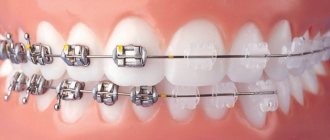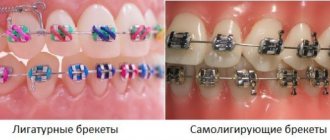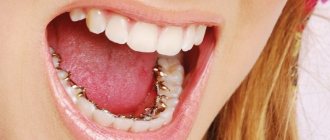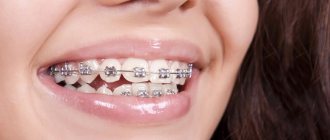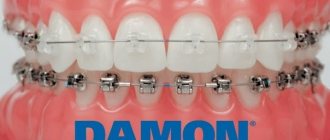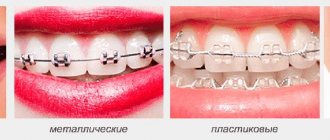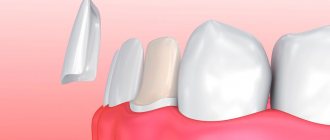Pre-installation inspection | Vestibular and lingual systems | Ligature and self-ligating braces | Advantages of metal devices | Disadvantages of metal braces | Comparison of metal and ceramic models | Popular Ormco braces | Installation | Diet and hygiene | Before and after photos | Reviews
Miniature metal braces made of steel or titanium alloy can withstand high mechanical loads. Durable metal structures correct complex dental pathologies, do not stain, and almost do not rub the mucous membrane. The bracket consists of a body, a base, a groove and wings. In passive self-ligating devices, the lid closes, turns the slot into a tube and holds the archwire. In ligature structures, the arc is fixed in the groove with elastic or wire ligatures. The weak forces of the orthodontic wires move the upper and lower teeth into the correct position. If necessary, the doctor installs elastics, springs and chains into the subligature space of the bracket limited by the wings. Additional elements speed up treatment and set the necessary vectors of orthodontic forces.
The material was verified by Ormco Russia product manager Alisa Sirotko.
non-ligated Damon Q on typodont
Metal braces are small in size compared to ceramic braces. When installing devices made of metal, hygiene is simplified; the material is not subject to corrosion and does not change color. Weak arch forces move teeth sequentially within the jaw bone.
Passive self-ligating metal braces Damon Q2 and Damon Q are made from 17-4 stainless steel. The bracket cover provides low arch friction in the lock and controls tooth rotation. In the grooves of metal non-ligature braces, the arch slides without obstacles, and treatment does not slow down. Metal ligature braces include, for example, Mini Diamond and Orthos. Clinical tests confirm the resistance of steel braces to the forces of arcs, springs and elastic traction.
Daimon Q on the crown of a tooth
Metal braces: pros and cons
Classic metal braces have been used in dentistry for over a hundred years. It is logical to assume that such a significant period indicates many advantages. Let's take a closer look at them.
- Metal braces are reliable and durable, so they are suitable for any clinical cases. They will help correct the most complex malocclusions and crowded teeth.
- The treatment period with metal braces will be shorter than with other systems (this is an important difference between ceramic braces and metal braces). Those patients who want to correct the defect as quickly as possible should choose them.
- Metal braces on teeth are more difficult to damage from hard food, and they are not stained by tea, coffee, wine and carbonated drinks with dyes.
- Finally, this is the most affordable type of orthodontic appliance. Getting metal braces cheaply is not difficult at all.
The disadvantages include the way metal braces look on your teeth. And although manufacturers are constantly improving the appearance of the structure - making smaller clasps and offering self-ligating metal braces without rubber bands or wires, the aesthetics of such systems still leave much to be desired. There is also the possibility of an allergy to the metal of the braces. Despite the use of only safe alloys - titanium, stainless steel, nickel, locks can cause an individual reaction. Before installation, patients prone to allergies must find out what metal the braces of the chosen brand are made of.
Braces on teeth for adults
Adult patients try to choose less noticeable systems to correct their bite.
- Women worry about having a beautiful smile. Representatives of the fairer sex prefer aesthetic materials (plastic, ceramics, sapphire) or prefer ligature locks. Visually, such designs do not spoil the smile line and are not very noticeable.
- Men worry less about their appearance during orthodontic treatment. The result is more important to them. Therefore, representatives of the stronger sex can choose both metal braces and aesthetic ones.
Types of metal braces
Based on the place of attachment to the teeth, braces are divided into vestibular and lingual. Another classification is based on the presence or absence of ligatures - auxiliary elements with which the braces are connected to the arch. Ligatures can be in the form of rubber bands or thin wires. There are also mini braces.
- Vestibular structures
are installed on the outer part of the teeth. These are ordinary metal braces that we are all familiar with. Such braces are more universal, correct a defect faster, do not distort diction and require less time to get used to. On the other hand, vestibular systems are visible on the teeth and can damage soft tissue. - Lingual metal braces
are installed on the inside of the teeth, so the brackets are not visible to others. This is an ideal solution for those who want to hide the fact of orthodontic treatment, for example, for public people. True, you will have to prepare for a longer period of bite correction, take longer to get used to the design, and also part with a much more significant amount. - Metal ligature braces
are visually more “heavy” and require frequent (every 3-4 weeks) visits to the orthodontist for correction, since the ligatures quickly stretch. However, some doctors consider such systems more suitable for difficult cases, and the cost of their installation is lower. - Metal non-ligature braces
Instead of ligatures, the systems use special latches or clamps. They do not block the arc, making the friction force minimal, which has a positive effect on comfort and treatment time. Patients with a metal self-ligating brace system can come for corrections half as often, and the procedure itself will last a matter of minutes. However, ligature-free braces are more expensive. - Non-ligature
For more comfortable and aesthetic treatment in orthodontics, special mini-designs have been developed. Their size is 20-30% smaller than standard braces, while the timing and effectiveness of treatment remain the same. This is a more aesthetic alternative to classic metal braces, which also does not require large expenses.
The mechanism of bite correction using braces
Pathologies of occlusion can be congenital, caused by genetic predisposition or abnormalities of intrauterine development, or acquired, caused by bad habits or injuries to the dentofacial apparatus. The use of brace systems in corrective therapy makes it possible to effectively eliminate occlusion defects regardless of the reasons that gave rise to them.
The essence of the mechanism for correcting anomalies is based on the ability of teeth to move from their place under the influence of directed mechanical force. During the treatment process, the bone tissue in which the dental elements are located is thinned in the direction of the movement vector, and a new one is formed in the opposite direction. Thus, the calculated force pressure helps the tooth occupy a new place in the dental row.
The mechanical impact to achieve the goal of corrective therapy is created using bracket systems - non-removable orthodontic structures fixed to the surface of the tooth enamel.
Metal braces from different manufacturers
- Damon Q metal braces
are perhaps the most popular on the market due to their patented design and locking system. The advantages of the Damon brand are reliability and reduced treatment time.
- Victory metal braces
from 3M Unitek are considered one of the most attractive metal solutions. They are distinguished by the anatomical shape of the locks and a special surface that facilitates installation. In addition, 3M metal braces belong to the budget category. - Metal braces “Pilot”
are a domestic development that combines an affordable price and quite a good level of efficiency. There are no innovative technologies here, but the solution copes with its main task. - Metal Marquis braces
from Ortho Technology are also in demand among doctors and patients. They are easy to use and especially hygienic: the clasps are precisely adjusted to the teeth and have a low profile, so they are comfortable to wear, and food residues will practically not get stuck between the elements of the system. At the same time, Marquis metal braces allow you to replace arches in the shortest possible time. - American Orthodontics Empower metal braces
are the flagship products in the orthodontic construction market. They are effective and reliable, as well as aesthetically pleasing due to the small size of the locks. However, the cost of their installation will be higher than many analogues. - Mini Master metal braces
from American Orthodontics are miniature in size (25% smaller than other systems). They are “shrunk” not only in width, but also in thickness, which eliminates injury to soft tissues. Mini Master also gives you the opportunity to wear colored metal braces of your favorite shade.
How often do you visit a doctor?
Treatment with ligature structures usually lasts from one and a half to three years.
To replace arches and ligatures, patients with classical systems visit an orthodontist every month. The doctor removes the ligatures, changes the archwires and puts on new elastic rings or fixes a metal wire on each bracket. The procedure takes from 20 to 35 minutes. Patients wear self-ligating devices for an average of one to two and a half years. The doctor makes an appointment once every two months and spends 15 to 25 minutes on the patient. Using a special SpinTek tool, the orthodontist opens the bracket cover and changes the arches.
positioning of the Damon Clear self-ligating bracket
Which metal braces are better?
You can choose one or another type of braces only after diagnosis, and also based on the financial capabilities of the patient. A metal ligature braces system would be the best choice if you need to save money, while metal self-ligating braces are suitable for busy people who are short on time. In addition, it is much easier to care for a structure without ligatures.
As for lingual systems, due to their cost and complexity of installation, they are not yet very popular in Russia, and finding a good doctor who specializes in such designs will not be easy. Therefore, based on a combination of factors, vestibular metal self-adjusting braces can be called the optimal solution.
The nuances of using ligature braces
There are certain points when wearing such designs:
- the elastic bands on the arches of ligature braces must be changed periodically, which requires frequent visits to the dentist;
- if there are hard ligatures in the braces, the process of treating the bite at certain stages may be accompanied by discomfort, the gums may rub, and friction can be felt on the teeth;
- according to dental statistics of bite correction in patients with different brace systems, the treatment process with braces with ligatures takes longer than in the case of solutions without ligatures;
- large dimensions of the design of ligature braces - it is definitely noticeable in the oral cavity (even sapphire options “match the color of the enamel”);
- When eating food that contains dyes, the rubber bands of ligature braces may become stained.
Installation of metal braces
In order to get metal braces, you need to go through three main stages.
- Diagnostic.
This includes: consultation with an orthodontist, medical history, radiography, orthopantomography, photographs of the patient from different angles, drawing up a treatment plan and choosing the appropriate brace system. - Sanitation of the oral cavity.
Treatment of caries and other diseases, elimination of foci of inflammation, if necessary, extraction of teeth or prosthetics, removal of hard deposits and plaque, strengthening of enamel. - Direct installation of a metal bracket system.
The last stage lasts no more than two hours. The doctor prepares the surface of the teeth, glues a separate lock-bracket to each tooth one by one, and fixes the adhesive solution with an ultraviolet lamp. If the locks are installed using the indirect method, that is, all at once, the procedure time is halved. He then connects the clasps to the archwire using ligatures or built-in fasteners. At the end, additional elements are installed - rings, cheek locks, hooks for elastic rods, springs, and so on.
In rare cases, metal braces are placed on one jaw. This is possible with slight curvature of the teeth, which does not affect the bite in any way.
Indications and contraindications for installation
Any type of treatment should be prescribed exclusively by a specialist. Therefore, identifying indications and contraindications for correcting occlusion defects is a priority step, without which corrective therapy cannot be started.
Indications:
- Incorrect position of the jaws or individual teeth
- Tremas and diastemas (large distances between dental elements)
- Crowding of dental units
- Deep or crossbite
Contraindications:
- Periodontitis and periodontal disease
- Endocrine pathologies
- Severe cardiovascular diseases
- HIV;
- Tuberculosis
- Bone diseases (osteoporosis, osteomyelitis)
- Bleeding disorder
- Edentia (absence of many teeth)
- Oncology
- Mental illness
Important: An orthodontist identifies indications for starting corrective therapy with braces only after conducting a thorough hardware diagnosis. This is necessary to develop an adequate detailed treatment plan.
How is treatment with metal braces performed?
Fixed orthodontic appliances apply constant pressure to the teeth, causing them to gradually move into the desired position. The arch plays a significant role in this process: at first it repeats the irregular shape of the teeth, but tends to return to its original position, thanks to which it smoothly corrects the bite. After each correction, the doctor changes the archwire to a thicker one to increase the pressure.
Let's look at why metal braces straighten teeth faster. The main quality of a metal system is its strength, and it does not really matter what metal is used in the braces. Due to the force of pressure, the teeth move faster and the treatment period is reduced. If the patient is faced with a choice between sapphire or metal braces, he must understand: although the sapphire design looks attractive, it will take a little longer to wear due to the fragility of the material.
So how long do you wear metal braces? Orthodontists call the average treatment period 1.5 - 2 years, but everything, of course, depends on the clinical case. The minimum period is 1 year for mild crowding of teeth, the maximum is about 3 years.
How long should you wear braces?
On average, it takes people at least 1 year to completely correct orthodontic defects. It takes approximately three years to correct even the most severe dental defects. The first results from the treatment can be seen already in the first 1 – 3 months from the moment of wearing. If you want to pre-calculate how long it will take to correct your bite in your particular case, consider the following factors:
- Your age;
- complexity of the defect being corrected;
- general condition of teeth;
- distance between teeth;
- type of construction (lingual/vestibular, ligature/non-ligature, metal/sapphire, etc.)
Hygiene rules and nutritional features
An integral part of orthodontic treatment with braces is constant monitoring of the condition of the oral cavity. After installing the system, if you experience discomfort or pain from rubbing, you should immediately contact your orthodontist. He will correct the design, apply special food-grade wax to the areas of braces that injure the gums, and prescribe medications for the treatment of inflammatory processes in the oral mucosa.
It is very important to develop good eating habits:
- do not eat solid food;
- healthy vegetables and fruits - only grated or cut into pieces, but in no case whole;
- exclude everything crispy and sticky (crackers, toffee, chewing gum, caramel, etc.);
- avoid sweets and soda to protect tooth enamel;
- Avoid very hot and cold drinks—temperature changes can cause braces to come off your teeth;
Anyone who wears braces is recommended to brush their teeth every time after eating, most thoroughly before going to bed. It is necessary to use tools such as:
- orthodontic brushes (with a small compact head and a V-shaped recess in the middle) for high-quality and gentle cleansing;
- dental floss (preferably orthodontic);
- an irrigator that will help remove food debris, plaque, and also prevent bleeding by massaging the gums;
- brush-brush for cleaning locks and removing stuck food in braces;
- restorative mousses with minerals.
It is recommended to visit a hygienist for professional teeth cleaning approximately once 3 months.
Features of the adaptation period
The patient should be prepared to experience discomfort for several days or weeks (depending on the threshold of sensitivity):
- rubbing of the mucous membranes of the lips and cheeks;
- violation of diction;
- discomfort when eating.
Expert advice for minimizing discomfort:
- to prevent chafing, you can use special wax (sold in pharmacies);
- for minor pain, you should rinse your mouth 3-4 times a day with saline solution (1 tsp per glass of warm water). The procedure cannot be performed if there are wounds and abrasions in the mouth. In this case, it is better to use a soda solution in the same concentration;
- In case of severe pain, you need to take a tablet of any painkiller. Note: strictly follow the dosage indicated in the instructions for the medicine;
- In the first days after installing braces, cancel intense physical training. Yoga exercises will help during this period;
- learn to chop food with a knife, exclude excessively hard or sticky foods (dried, dried) from your diet. During the first few days, the products can be ground in a blender.
Attention: if the pain is severe and does not go away within several days, then you should definitely consult your doctor.
What is the difference between ceramic braces and metal braces?
Many patients are interested in what is better - ceramic or metal braces. You need to understand that both types of systems cope well with their task, the only question is in the details.
When choosing ceramic or metal braces, you should decide on your priorities: aesthetics or treatment time? Ceramic systems are practically invisible on the teeth, and this makes the correction psychologically more comfortable. On the other hand, if it takes a year and a half to correct a moderate defect with metal braces, then with ceramic braces it will take about two years.
Lifestyle will help you understand which braces are better - ceramic or metal. Metal is much less capricious: it does not stain under the influence of red wine, tea and coffee, and is also not prone to chips and cracks.
Another popular question is whether it is possible to smoke with metal braces. If we do not take into account the harm from smoking as such, then it is really better for smokers to install a metal system, since ceramics can change color under the influence of resins.
Types of ligature systems
The main classification of braces is carried out depending on their positioning:
- those fixed on the outer side of the dental row are called vestibular;
- attached to the inner surface - lingual.
The material used to make orthodontic products also affects the type of bracket system:
- metal – bracket plates are made of a hypoallergenic metal alloy (cobalt, nickel or gold). Such designs are very reliable, efficient, affordable in cost, but their appearance is not aesthetically pleasing;
- ceramic - made of high-strength ceramics. Their color practically matches the shade of natural tooth enamel, so they have a high level of aesthetics. Cannot be used if excessive force pressure must be applied to correct defects (i.e., to correct severe pathologies). The price of such systems is significantly higher than similar metal products.
Combined braces: metal and ceramic
To save on installing an aesthetic system, you can choose combined metal and ceramic braces. When a person smiles, the lower teeth are less visible, so to save money it is worth putting metal braces on the lower jaw and ceramic braces on the upper jaw. This is a worthy compromise between the cost of treatment and psychological comfort during it. Similarly, you can combine sapphire with metal.
Aesthetic ligature models Ormco
Inspire ICE aesthetic braces are made from artificially grown sapphire. The transparent single crystal is hardly noticeable on the teeth, and the ligature wings and base are stronger than those of the Spirit MB plastic device. Unlike ceramic, sapphire ligature braces look completely transparent.
aesthetic Inspire ICE
Is it possible to get metal braces inexpensively?
Undoubtedly. Installing regular staples is the cheapest. However, the price of metal braces can vary. Designs with ligatures will cost the least - from 25,000 rubles, a metal non-ligature bracket system starts at 35,000 rubles. Of course, we are talking about vestibular structures, since the price list for lingual systems starts from 100,000 rubles. Ceramic braces with a metal groove will be an order of magnitude more expensive than a conventional system. You also need to keep in mind that metal braces for the upper jaw are more expensive than for the lower jaw. Such designs are the most affordable, and this is also the difference between metal and ceramic braces. The table below will help you navigate the cost of metal structures, as well as a call to a clinic where you can install braces in Moscow.
| Bracket systems | Price |
| Vestibular | from 50,000 rubles |
| Lingual | from 100,000 rubles |
| Mini | from 30,000 rubles |
| Ligature | from 25,000 rubles |
| Unligated | from 35,000 rubles |
Braces on children's teeth
Children with braces walk on the initiative of their parents. Therefore, the choice of system often falls on the shoulders of fathers and mothers. They are not very worried about the appearance of the child’s smile, so they usually choose metal budget structures. Such records look normal and are noticeable to others. Children often prefer ligature correctors and choose colored elastic bands. The appearance of the smile will depend on the teenager’s preferred color scheme and imagination.
- Girls choose ligatures of bright and rich shades, which is how the smile turns out. Older girls choose plastic on which patterns can be applied. Sapphire locks, reminiscent of iridescent stones, are also a priority, but their cost often stops parents.
- Boys choose small metal pads with self-ligating locks. They also prioritize plastic, which is relatively inexpensive and not very noticeable to others.
- Figured and colored. Curly locks are made individually at the request of the patient. In teenage boys and girls, their imagination knows no bounds, so the appearance of a smile will depend on the idea. Girls often prefer locks in the shape of hearts, flowers, and stars. Boys prefer rectangular or square colored pads.
How they work and how they work
The braces system is a complex device that allows you to move teeth in different directions , but the principle of its operation and structure are quite simple.
Structure:
- Power arc. It has “shape memory,” i.e., when it is installed in the bracket grooves, it takes on the previous configuration.
Each bracket is responsible for a specific tooth, and the power arc transfers the load to them. - Individual locking device (bracket). It can have a variety of shapes and sizes, but in general its structure is the same.
The bracket structure includes: a support platform with a groove for the arch placed on it, and wings, with the help of which the arch is fixed with a ligature. - Orthodontic rings. There are 2 options for attaching the bracket - gluing with a composite material or welding to a ring placed on the tooth. They are usually placed on the molars, ensuring that the braces adhere tightly to the jaw.
- Elastic or metal ligatures. In the first case they are rubber rings, in the second they are a kind of wire. A detail such as a ligature allows you to reliably fix the arch in braces in the correct position.
- Wings that allow you to attach arches to braces using ligatures.
The effectiveness of the entire structure as a whole depends on each of these elements. When installing the system, the locks are attached to each tooth and then connected with an archwire. It is installed in the groove and secured with a ligature.
Fixed appliances work by applying constant pressure to the teeth. The arch, trying to take its previous shape, puts pressure on certain teeth, thereby correcting the position of the entire dentition. Teeth move rather slowly, which affects the timing of orthodontic treatment.
An arch is made to individual sizes for each person. It is designed to form the correct bite. After installing the locks, it is attached to them and performs its function - it exerts pressure on the jaw, trying to return to its original position.

